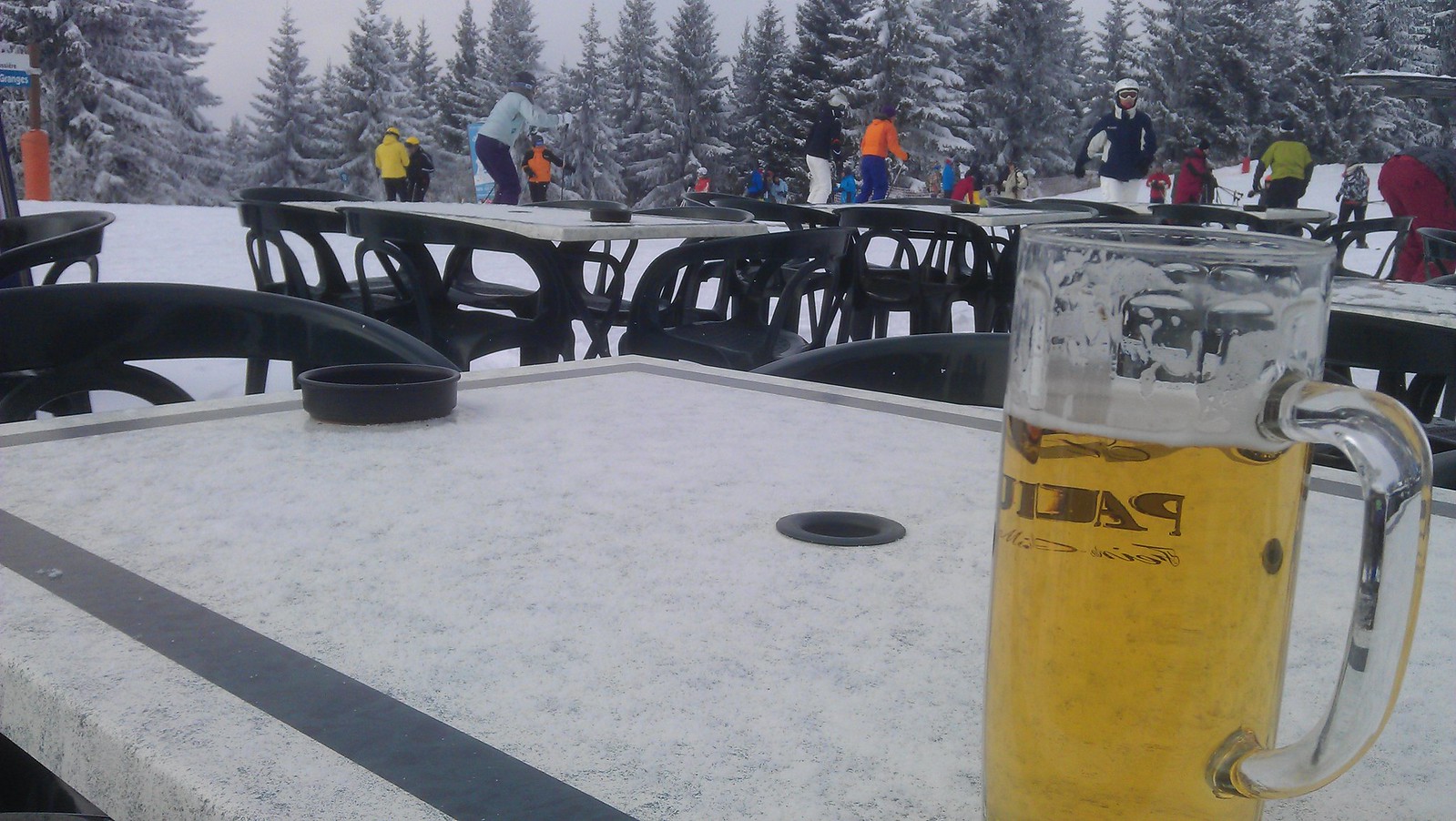Home › Forums › Chat Forum › The STW Ski & Snowboard thread. The 2013-2014 season
- This topic has 1,485 replies, 126 voices, and was last updated 10 years ago by nedrapier.
-
The STW Ski & Snowboard thread. The 2013-2014 season
-
fluxhutchinsonFree MemberPosted 10 years ago
Hi everyone. Got my first ever snowboarding holiday booked in January, going to serre chevalier and I’m just wandering if anyone takes a camelbak for hydration or do you fill you pockets with bottles? or is it a case of just finding a cafe?
TIA
DigbyFull MemberPosted 10 years agoOff-piste guiding should be with a UIAGM or similar – look at the fuss the french have made about the qualification requirements for mtb guides in the alps! ESF and Evolution2 will only take someone off-piste with a qualified guide. The guide will evaluate the conditions on behalf of the clients.
Itineraries are just ungroomed pistes surely? If they are subject to closure, then they are patrolled and evaluated and therefore don’t really constitute ‘off-piste’ orthe type of terrain I’m referring to since it’s clearly marked. For example the run from the Lognan down the glacier de rognon at grand montet and the runs off the youla and arp in courmayeur are closed when conditions are poor.
What i was trying to ascertain was how do folks evaluate conditions for terrain that falls between a run defined on a map/with poles etc and the backcountry … this seems to be the grey area where a number of these incidents occur! 🙁
jambalayaFree MemberPosted 10 years ago@flux your camelback hose will likely freeze (especially in January !) – you can get covers for the tube. I sometimes carry a small bottle of water in my backpack if I’m wearing it otherwise I dont bother. “Rehydration” occurs at suitable outlets on the mountain 🙂
jambalayaFree MemberPosted 10 years ago@Digby I’m most familiar with the itineries in Verbier (Switzerland) and they are not patrolled. They are declared open or closed generally based upon avalanche risk and they are scouted as such. They tend to have a variety of alternative lines some of which can be quite far from the poles. Another resort I’m familiar with is Val d’Isere where the main off piste routes are pretty well known and I would say some of the easier ones are skied by most people without a guide.
DigbyFull MemberPosted 10 years ago@flux – if possible, avoid taking a backpack when riding in resort. Not only can they throw you off-balance when riding but they can be awkward for you and your fellow passengers on the chair lifts! Don’t risk spoiling your important first snowboard holiday! Plenty of places to re-hydrate in resort! 🙂
GrahamSFull MemberPosted 10 years agoanyone takes a camelbak for hydration or do you fill you pockets with bottles? or is it a case of just finding a cafe?
Cafe usually for me. No shortage of them in most resorts. Don’t usually snowboard with a pack on at all.
Hip flask sometimes… 😉….. for the majority of winter ‘sports’ enthusiast heading to the Alps etc – hitting up the easy access off-piste freshies has become a modern right of passage, but few are perhaps aware of the potential dangers
Completely understand your point. I guess one issue for the resorts is that the more layman information they give out regarding how safe or otherwise the off-piste is, the more they open themselves up for being sued when someone is inevitably killed on a “safe” day. Hence they mainly just publish the facts about weather, snowpack etc and leave the final decision to the skiers.
I think the other issue is that for many of us we only get away for one or maybe two weeks a year. And we might only get a chance at good off-piste for a few days of that. So spending thousands on avalanche gear and training courses, plus doing regular rescue drills etc, can seem a bit disproportionate and OTT.
I’m not sure I know what the answer is there. 😕
DigbyFull MemberPosted 10 years ago@jambalaya – apologies, i guess we’re using the same word with different meanings. Scouting and evaluating a run or piste and then declaring it open or closed constitutes ‘patrolled’ in my book. Sorry for any confusion.
RioFull MemberPosted 10 years agoI’m not sure I know what the answer is there.
I would have thought the answer was simple; if you want to go off-piste and don’t have the training and/or equipment to do it safely yourself then hire a guide. They’ll take you to the best places within your ability and within the safety limits of the off-piste areas, and the better guiding companies will be able to provide transceivers as part of the service.
GrahamSFull MemberPosted 10 years agoI would have thought the answer was simple; if you want to go off-piste and don’t have the training and/or equipment to do it safely yourself then hire a guide.
That’s fine for “proper” off-piste but do you really expect someone to hire a guide for 500metres of in-bounds slackcountry between two pistes?
I think Digby’s point is that there is a pretty large grey area of slack and “just” off-piste which is the domain of noobs and part-timers like me which can be difficult to assess or get clear info about.
Flashy’s lift run in Serre Che is a good example.
SpinFree MemberPosted 10 years agoThere’s no lack of avalanche info in europe. Forecasts are on line and posted on notice boards at tourist info, guides offices, pisteurs huts and lift stations.
The problem is that a huge number of people either don’t know that, don’t think it’s relevant to their activities or don’t have the skills to interpret that info.
RioFull MemberPosted 10 years agoin-bounds slackcountry between two pistes
In North America, where there’s in-bounds and out-of-bounds, then possibly not. In Europe generally there’s on piste – i.e. between the piste markers – and there’s off-piste, which is not between the piste markers. I don’t think I’ve come across any “in bounds/out of bounds” concept in Europe. The term “slack country” is not meaningful.
Go off-piste and you need to know what you’re doing and have appropriate equipment and insurance in case you’re the one that causes the avalanche onto the piste below. Obviously there’s an element of risk management in all of this – if a bit of off-piste has been well used and the snow pack is stable then you might still feel it’s ok to go there, likewise if it’s obviously not steep enough to avalanche.
As for the equipment being expensive – a Pieps freeride is not brilliant for searching but will help mountain rescue find the body and you can get one for less than £100.
CaptainFlashheartFree MemberPosted 10 years agoJambalaya, there are deceptively steep bits either side of the piste. To the right (looking down) is a very shaded area that gets super steep (Some nice couloirs for boothiking up to, however). To the left, there are gullies that could present a risk of smaller avalanches tumbling down the gully itself. I suspect it was up to the right.
Flux, I never bother taking water on piste. Every place you stop for a coffee/lunch etc on the mountain will have jugs of water and glasses freely available. In many, they’re put on your table before you’ve even had a chance to ask for it!
Top slope-stops at Serre Che for you;
Le Bercail, at Aravet. Lovely sun trap, great food. Try the sugar cubes…..! At the bottom of the piste here, in line with the trees to the left
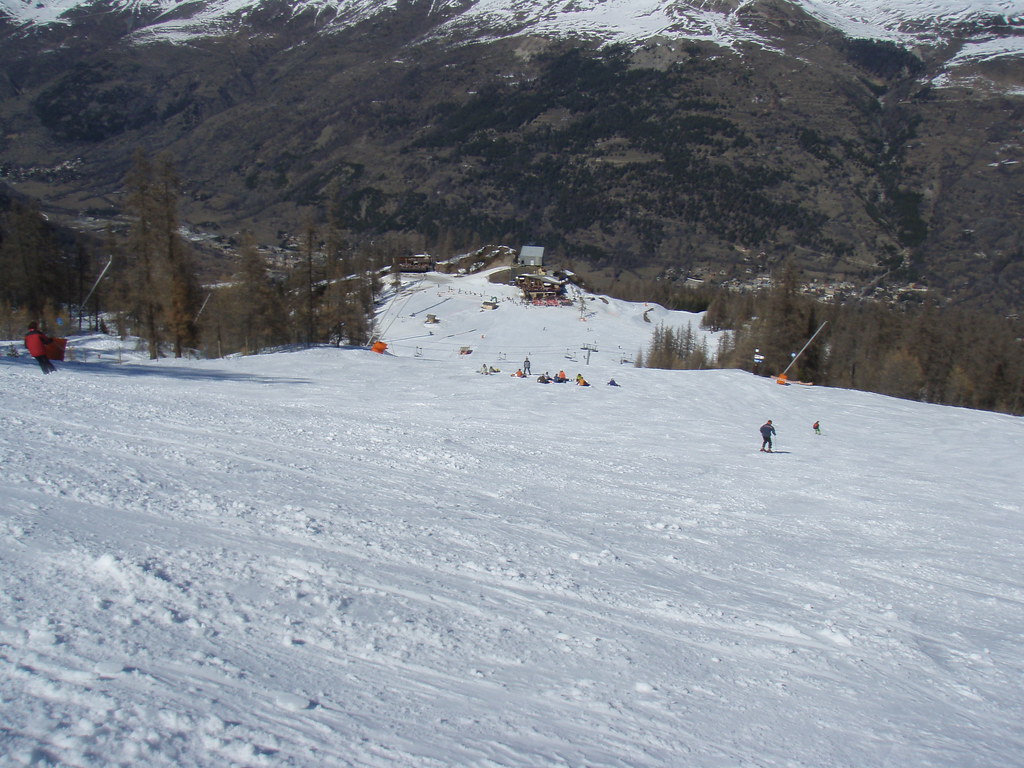 [/url]
[/url]Little cafe just off the Cucumelle piste, in Frejus.
 [/url]
[/url]The Terrace, at the bottom of the Luc Alphand, to the left hand side as you ski down.
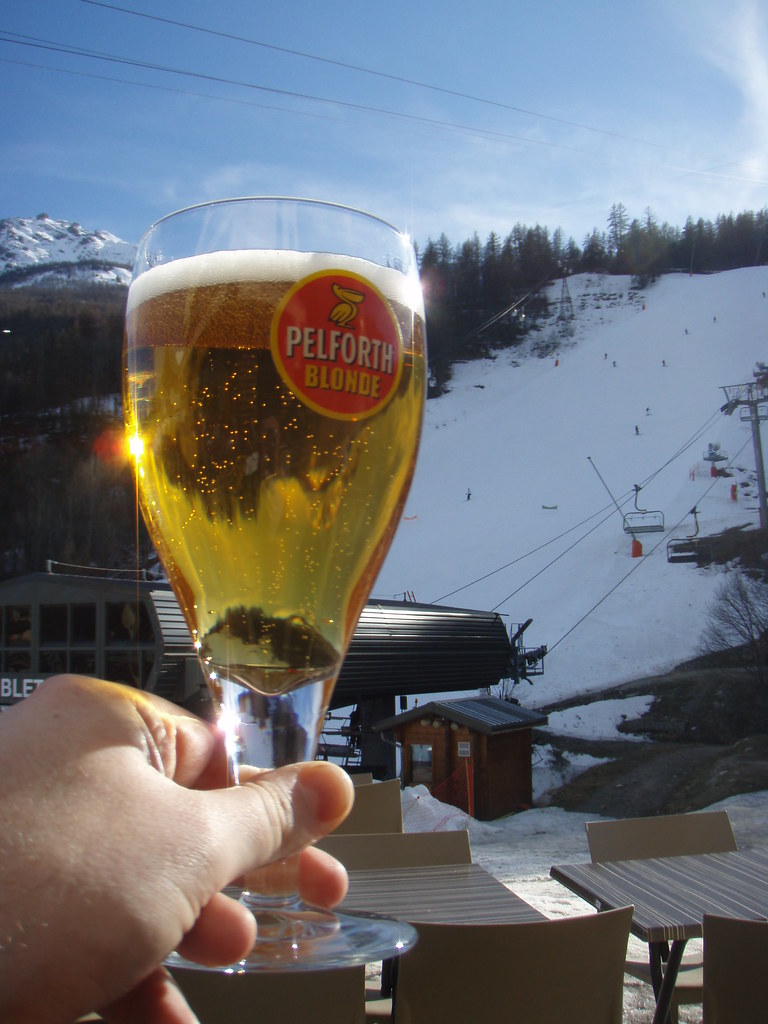 [/url]
[/url]The Station, at the right hand side of the bottom of the Alphand used to be great for a few rowdy beers and the Harper Brothers, but not sure what’s happened there since their recent fire.
CaptainFlashheartFree MemberPosted 10 years agoSpin – Member
There’s no lack of avalanche info in europe. Forecasts are on line and posted on notice boards at tourist info, guides offices, pisteurs huts and lift stations.The problem is that a huge number of people either don’t know that, don’t think it’s relevant to their activities or don’t have the skills to interpret that info.
Interesting piece in the paper today about the fact that skis and kit are now marketed as being more gnaaar, and so people feel that they can just hop off to the steep and deep stuff without a care.
http://www.telegraph.co.uk/travel/snowandski/10542580/Skiing-British-snow-gobblers-who-ignore-dangers-of-a-winter-wonderland.htmlDigbyFull MemberPosted 10 years agoI think the other issue is that for many of us we only get away for one or maybe two weeks a year. And we might only get a chance at good off-piste for a few days of that. So spending thousands on avalanche gear and training courses, plus doing regular rescue drills etc, can seem a bit disproportionate and OTT
I think you’ve possibly hit the nail on the head there GrahamS! Appreciate your honesty and candidness.
It occurs to me that this is a relatively new phenomenon – but one that also occurs in other areas of ‘The Great Outdoors’ with more people heading out without the basic kit or skills – much to the chagrin of various mountain rescue teams. It doesn’t happen (at least as far as I’m aware) with activities like sailing etc – I guess the perceived danger of drowning is drilled into us from a young age, whereas the danger of avalanches etc aren’t.
Getting the kit and skills needn’t cost the earth though … what price your life or the life of a love one?
The alternative is that fatalities increase and a knee-jerk reaction results in backcountry access being restricted for everyone. Similar restrictions have been muted when fatalities of climbers & mountaineers increase.
Be safe out there folks!!
I_AcheFree MemberPosted 10 years agoI took my camelback the first couple of times away but last year the hose kept freezing so it was just annoying. Bags can be handy but as with cycling they just encourage you to carry stuff ‘just in case’. And you end up with a big weight on your back that also makes it a bit sketchy getting on and off chairlifts.
This year I wont be taking my bag but I will make sure I have plenty of beer money while I am on the hill. There are plenty of opportunities to chill out with a drink.
DigbyFull MemberPosted 10 years agoInteresting piece in the paper today about the fact that skis and kit are now marketed as being more gnaaar, and so people feel that they can just hop off to the steep and deep stuff without a care.
exactly CFH – a little sensational but the article possibly summarises what I’ve been trying to articulate (only slightly more succinctly)
lol @ “les bouffeurs de neige” though … gotta love those French turns of phrase!
jambalayaFree MemberPosted 10 years ago@Digby no apology needed, I use the term patrolled to mean someone skis down at end of day (at least) to check
@CFH I see now where you mean.
On skis I would say the new equipement opens up off piste to a much wider group and the kit encourages people to ski there to try it out. I’ve been skiing 35 years and my off piste technique is so much better now (ie it’s the skis really). Also IMO boards are designed for off piste. Frankly once you’ve been skiing a few weeks most people are going to try off piste, I took one of my daughters boyfriends off piste after 4 days, he was a natural boarder (v good skate border and DH mtb-er so had the balance skills) and just lapped it up. So yes the kit allows you to access off piste more than ever.
Finally as I posted on the Schumacher thread French TV said he was skiing fast and actually broke the helmet in two on the rock, they also showed a relatively flat area so it makes sense he was carrying speed to clear out off the slope. That’s actually just how I bust my knee last year, skied the hard part, concentration lower building speed to allow me to reach the piste. All supposotion of course but it makes some sense. From my memory of Meribel that area isn’t that steep or technical (unlike the colouirs from the very top), I’ve skied between the runs there often.
DigbyFull MemberPosted 10 years agoAlso occurs to me that whilst CFH’s Daily Telepgraph article makes some interesting points from the perspective of ski guide Thomas Weller, there is no mention of the requisite skill and equipment required for off-piste skiing … on the contrary the emphasis of the article is regarding helmets and the fact that ‘only around 40 per cent of skiers opt to wear one.’
stilltortoiseFree MemberPosted 10 years agothey also showed a relatively flat area so it makes sense he was carrying speed to clear out off the slope
Sounds familiar. Last day and last run of my last trip I was straight-lining on an icy and very shallow-angled slope to make sure I got to the end without having to take the board off and walk. Edge caught some ice and I took a good old whack to the head. It’s too easily done and it made me think very hard about wearing a helmet. Not been ‘boarding since 😆
nedrapierFull MemberPosted 10 years agoInteresting piece in the paper today about the fact that skis and kit are now marketed as being more gnaaar, and so people feel that they can just hop off to the steep and deep stuff without a care.
And it’s not just the skis – Seen that Ford ad with the guy skiing on his own, outrunning an avalanche? Ain’t no thang for the kind of dude who drives a Ford!
CaptainFlashheartFree MemberPosted 10 years agoDigby, the helmet argument will always trump anything in a media storm like this, as it’s the easy way out.
A quick look at some of the imagery used by the bigger and smaller stores selling ski kit in the UK, though, shows that the zeitgeist is all about shredding the gnat and getting off piste these days. As Graham says above, for most of us it’s a week or two once a year, with a little smattering of back/slack or a day’s guided fun in the steep stuff (Which is about where I am these days!), but the marketing, the images, the kit, etc is all moving towards bigger, deeper and steeper.
It’s almost like skiing/boarding is going through it’s own huck it years.
DigbyFull MemberPosted 10 years agothe helmet argument will always trump anything in a media storm like this, as it’s the easy way out.
Sadly CFH I think you’re right … reminds me of last year when the media stirred up a storm over Wiggo’s helmet comments …
A quick look at some of the imagery used by the bigger and smaller stores selling ski kit in the UK, though, shows that the zeitgeist is all about shredding the gnat and getting off piste these days
Couldn’t agree more – but then this is an industry struggling at the moment (although some reports maintain that it’s bottomed out Linky)
Either way the industry is keen to use the ‘Extreme’ images of winter hobbies to promote it as a ‘lifestyle’ choice – case in point nedrapier … dontcha just wanna grab yourself a Ford! 😉
stevomcdFree MemberPosted 10 years agoBUT.. if it is outside patrolled piste then my understanding is that they no longer have any duty of care, responsibility for your safety or any legal obligation to rescue you.
This is broadly correct. In theory, if you’re off-piste, then you’re a job for Mountain Rescue, not for Ski Patrol.
Weirdly, this also means that rescue is likely to cost you less as most French communes no longer charge for mountain rescue, whereas ski patrol do!
Off-piste guiding should be with a UIAGM or similar – look at the fuss the french have made about the qualification requirements for mtb guides in the alps! ESF and Evolution2 will only take someone off-piste with a qualified guide.
Not sure what you’re getting at here, but it is completely normal for a fully-qualified ski/snowboard instructor (i.e. not a UIAGM guide) to take people off-piste and both ESF and Evo2 most definitely use instructors in this way.
The debate about instructors vs guides in terms of off-piste safety training is an old one. Suffice to say that instructors are pretty well-trained in this.
jambalayaFree MemberPosted 10 years agoFrench media was talking yesterday about a 50yr old skier in same unit as Schumacher with similar injuries, he was sking on piste and was wiped out by a young boarder. There was much coverage about fact French adults are much less likely to wear a helmet than other nationalities. I’ve worn a helmet for 10 years partly after taking a heavy fall and hitting my head on an icy mogul and partly as some security against being wiped out (have had two experiences with people I’ve been skiing with being totally smashed by boarders). Snow boarding without a helmet is madness IMO given the nature of the average fall.
BunnyhopFull MemberPosted 10 years agosketchy getting on and off chairlifts.
This point about wearing a back pack is a good one. I used to wear a dakine pack on almost every trip, however I once had the huge embarrassment of getting the straps caught when dismounting the chairlift, luckily I was able to wiggle the strap and jumped down. On some chairlifts this would be positively dangerous, never mind the ‘feeling a fool’ factor.
Note that the lifties prefer you to take the pack off and have it on your knee, this imo also causes many embarrassing dismounts.
Nothing funnier than someone with all the gear looking like a complete idiot, that’s me that is.DigbyFull MemberPosted 10 years agoNot sure what you’re getting at here, but it is completely normal for a fully-qualified ski/snowboard instructor
Sorry stevomcd, I did start to try and list what my understanding is regarding the different instructor/guide qualifications (ISTD, EMS, ISIA, UIAGM/IFMHA and probably a few more) and what the distinctions are regarding off-piste instruction/guiding are but it got convoluted and verbose* … my comment regarding Evo2 & ESF was more in line with off-piste terrain like the Vallee Blanche.
I guess that this highlights again the fact that the term off-piste is very broad and I’m sure there are loads of grey areas.
The point I was trying to get across was that the French in particular are very keen on people having the requisite qualifications for the level of instruction/guiding they are providing. I know it’s possibly semantics but jambalaya’s comment was:
Numerous companies and the official ski schools offer off piste guiding
I was trying to point out that off-piste guiding requires an appropriately qualified guide [and by inference off-piste instruction requires and appropriately qualified instructor]
* told you it was verbose! 🙂
DigbyFull MemberPosted 10 years agoBTW – if anyone is interested in what it takes to become a High Mountain Guide then Neil McNab (the author of the Snowboard book GrahamS mentioned earlier) wrote an interesting article a while ago:
http://www.mcnabsnowboarding.com/advice/page/81
Andy Cave (climber & author) likened the UIAGM/IFMHA qualification to a PhD …
SpinFree MemberPosted 10 years agoJust about enough snow on Cairngorm today but crap vis, high winds and all the uplift off bar the funicular.
It beats me why people are willing to pay for crap like that. I was on the touring kit so it only cost me a few quid in petrol to work out it was sh!t then head for a cafe.
grumFree MemberPosted 10 years agoHow many times per day would be considered obsessional when checking snow forecasts? 🙂
eskayFull MemberPosted 10 years agoJust got back from Finland and the skiing was mixed. Very good snow when we first got there but the the temperature (unusually) rose to about 1-2 Deg C for a day which then made conditions quite icy when the temperature dropped again. We then had some good snow for the last couple of days.
Inghams brochure for next season was on the mat when we got back….!

Stumbled across a heard of marauding reindeer on one day’s skiing. They were not at all fazed by us watching them foraging for food.
stevomcdFree MemberPosted 10 years agoDigby – fair enough, just wasn’t sure what you were getting at.
In simple terms, the distinction is it has to be a guide when glaciers or serious climbing are involved. In Chamonix, this is a big deal as there is so much glaciated terrain, as well as a lot of classic runs which require climbing or abseils to access them. Elsewhere (here in the Tarentaise, for example) it’s much less of an issue.
On my EMS exam in March BTW… 😉
CaptainFlashheartFree MemberPosted 10 years agoRight, you lot. For all of you going out to play this year, I expect, nay I DEMAND, pictures! 🙂
(Seeing as I’m going to be lucky if I can get a cheeky weekend’s skiing in this year, I shall ski vicariously through all of you. Especially anyone going to Serre Che. )
grumFree MemberPosted 10 years ago‘Shitloads’ of snow in Les Arcs today according to my mate there. 🙂
DigbyFull MemberPosted 10 years agoas well as a lot of classic runs which require climbing or abseils to access them
– yeah – I’ve done quite a few of them with Neil, (and some of the guides he had working with him a few years ago) … some of them are pretty ‘exposed’ for sure!
I was hoping to get on the McNab ‘Steep & Deep’ course this year as I really fancy the ENSA couloir etc, but I dithered and missed out as the places filled up really quick. 🙁
Very best of luck with the EMS stevomcd! 🙂
nedrapierFull MemberPosted 10 years agoLong post with pretty pictures! Sparked by talk of steep Cham, some reminiscing for me, and some vicarious skiing for CFH.
I spent an amazing February in Chamonix a few (erk! 11!) years ago. Arrived at the end of a big dump, then 3 weeks of clear weather and an ever-stabilising snowpack. Ticked off a lot, skiing with whoever was free with the best plan – I knew a few people living there for the season or longer, so had access to all their buddies too. One of the most memorable routes was the Cosmiques couloir.
We started late, which wasn’t clever, but it made for added adventure and some amazing light. It was a bit thin at the top, so we took 2 and bit pitches of abseiling on a doubled 60m rope to find a spot to strap in. Which was the most puckering experience: taking my pack off on steep, hard snow, unclipping my board, strapping in and getting the pack back on without dropping anything. First time I’d seen my board as life preservation equipment. Lose a board there, and it’s 70m of mixed climbing back up and then a long walk over the glacier then round and up the arete to the lift. And a cold night on the floor at 3800m, given how late we’d left it. And 2 angry friends!
No dramas though, apart from a lost lens cap.
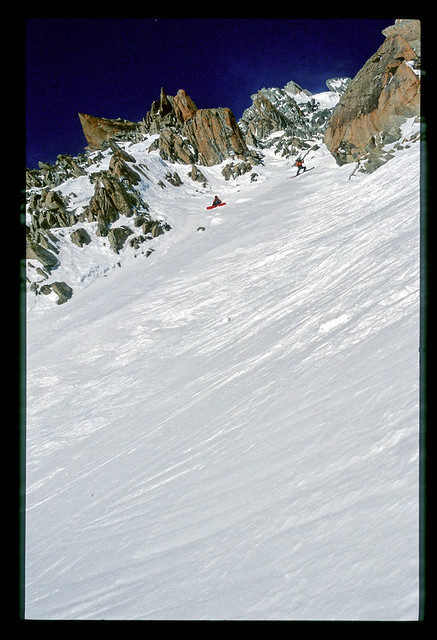
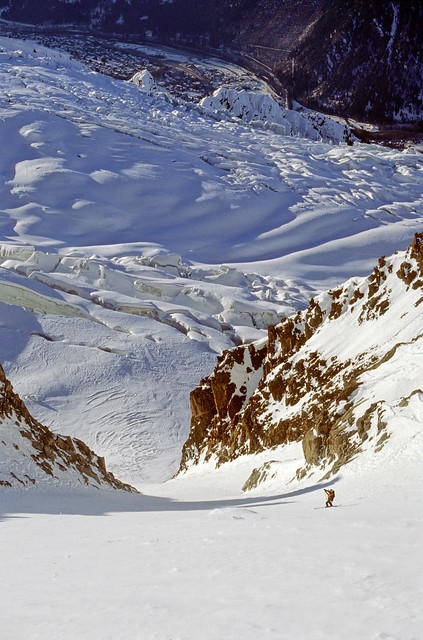
Until the bergschrund at the bottom of the couloir.
Picking a line over wasn’t too easy as it was almost invisible from the top. Luckily we had a skiier with us who volunteered to stomp around and find the best spot to drop. Experienced guy, his dad’s a guide, he was talking fairly casually and matter-of-fact. Not being any the wiser at this stage, I was fairly calm too.
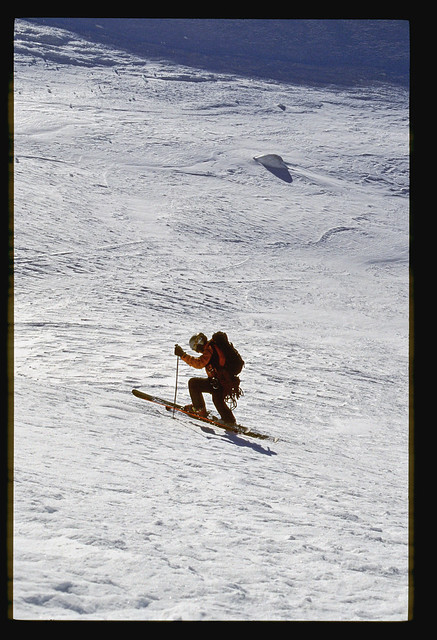
I did get the jitters seeing him ready himself after he found his spot, crouched, coiled, did that little foot shuffle that ski racers do in the start gate, 3 hard exhales to gee himself up, and then a half jump kick start to point it over the edge. “****! Not nothing, then!” He lost it on the landing (still hard down there too) then burst out laughing in relief. Told me to do exactly what he’d done, that I needed some speed. Understandably nervous now, I followed his line, cacked myself in mid-air when I looked down into a 6 foot wide black maw, god knows how deep. No bothers clearing it, though, given the drop and some speed. The landing was the same too@: lost it on impact, then lost it laughing!
Then we had to be serious again and talk Neil down. It wasn’t really a problem, but as John had to with with me, you couldn’t understate it and risk someone not clearing it!
drop, bail, laughter.
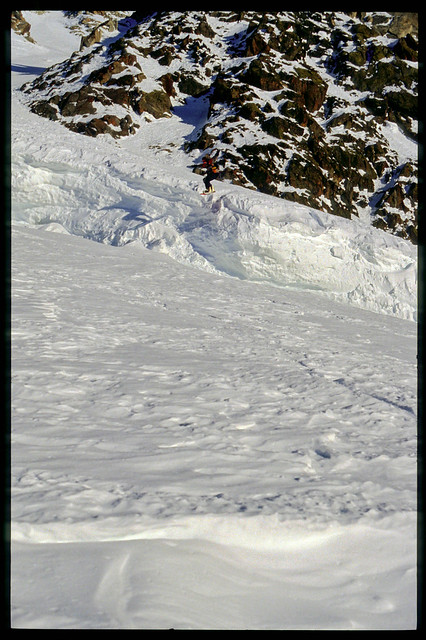
REALLY fun riding from there down to the treeline, amazing blue and orange light, couple of water ice jibs and then 20 turns of sunset fluff under the old lift line. Combat skiing from there to the road in knee deep porridge, a lost ski given up on, then found through sheer dumb luck, and a sit on a stone bridge over the Dard stream, looking at the first stars.
A beautiful day that will stay with me for ever!
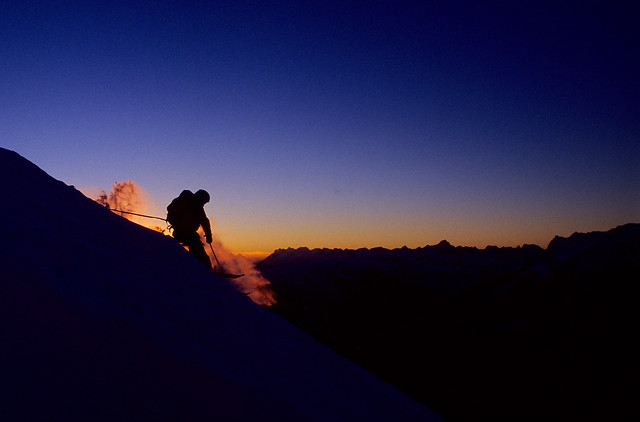 jambalayaFree MemberPosted 10 years ago
jambalayaFree MemberPosted 10 years ago@ned – thanks for sharing, that’s fabulous. It’s quite intimidating when you look down and see nothing but cold blue ice and a dark abyss which can entomb you for 1000 years ! Had a couple of good friends and excellent who did seasons in Chamonix (in their 30’s on career breaks) if you want it it’s full on there for sure.
Nothing quite so dramatic for me but 2 of us did the “path of the goat” once, I understand it’s rarely skiable. The guide was a doctor on a break, the surroundings where epic and skiing pretty straight forward technically so really fun. We had to climb down a frozen waterfall with a rope but we felt fairly lame after the guide picked his way down without it. After a traverse across a somewhat unstable slope which had chucks of sharp rock dropping down on us we got to the staircase under the lift which was officially closed but the operator had seen us coming and was waiting. We staggered exhausted up the steps whilst the guide ran up with our skis/board, we were truely humbled !
The topic ‘The STW Ski & Snowboard thread. The 2013-2014 season’ is closed to new replies.

